Train Strategies for Haptic and 3D Simulators to Improve the Learning Process in Dentistry Students
Abstract
:1. Introduction
2. Materials and Methods
3. Results
4. Discussion
5. Conclusions
Author Contributions
Funding
Institutional Review Board Statement
Informed Consent Statement
Data Availability Statement
Acknowledgments
Conflicts of Interest
References
- Prastiyani, N.H.N.; Felaza, E.; Findyartini, A. Exploration of constructive feedback practices in dental education chairside teaching: A case study. Eur. J. Dent. Educ. 2020, 24, 580–589. [Google Scholar] [CrossRef] [PubMed]
- Ciardo, A.; Möltner, A.; Rüttermann, S.; Gerhardt-Szép, S. Students’ self-assessment of competencies in the phantom course of operative dentistry. Eur. J. Dent. Educ. 2019, 23, 204–211. [Google Scholar] [CrossRef] [PubMed]
- Huth, K.C.; Baumann, M.; Kollmuss, M.; Hickel, R.; Fischer, M.R.; Paschos, E. Assessment of practical tasks in the Phantom course of Conservative Dentistry by pre-defined criteria: A comparison between self-assessment by students and assessment by instructors. Eur. J. Dent. Educ. 2017, 21, 37–45. [Google Scholar] [CrossRef] [PubMed]
- Mason, D. Oswald Fergus, a Pioneer of Simulated Dental Clinical Practice; The History of Dentistry Research Group Newsletter: Glasgow, UK, 2006. [Google Scholar]
- Coro Montanet, G.; Gómez Sánchez, M.; Suárez García, A. Haptic simulators with virtual reality environments in dental education: A preliminary teaching diagnosis. @Tic Rev. D’Innovació Educ. 2017, 18, 14–21. [Google Scholar] [CrossRef]
- Quinn, F.; Keogh, P.; Mcdonald, A.; Hussey, D. A pilot study comparing the effectivenessofconventional training and virtual reality simulation in the skills acquisition of junior dental students. Eur. J. Dent. Educ. 2003, 7, 13–19. [Google Scholar] [CrossRef]
- Bholat, O.S.; Haluck, R.S.; Kutz, R.H.; Gorman, P.J.; Krummel, T.M. Defining the role of haptic feedback in minimally invasive surgery. Stud. Health Technol. Inform. 1999, 62, 62–66. [Google Scholar]
- Kitagawa, M.; Dokko, D.; Okamura, A.M.; Yuh, D.D. Effect of sensory substitution on suture-manipulation forces for robotic surgical systems. J. Thorac. Cardiovasc. Surg. 2005, 129, 151–158. [Google Scholar] [CrossRef] [Green Version]
- Ström, P.; Hedman, L.; Särnå, L.; Kjellin, A.; Wredmark, T.; Felländer-Tsai, L.; Ström, P.; Hedman, L.; Särnå, L.; Kjellin, A.; et al. Early exposure to haptic feedback enhances performance in surgical simulator training: A prospective randomized crossover study in surgical residents. Surg. Endosc. Other Interv. Tech. 2006, 20, 1383–1388. [Google Scholar] [CrossRef]
- Rhienmora, P.; Haddawy, P.; Dailey, M.N.; Khanal, P.; Suebnukarn, S. Development of a dental skills training simulator using virtual reality and haptic device. NECTEC Tech. J. 2008, 8, 140–147. [Google Scholar]
- Rhienmora, P.; Haddawy, P.; Khanal, P.; Suebnukarn, S.; Dailey, M.N. A Virtual Reality Simulator for Teaching and Evaluating Dental Procedures. Methods Inf. Med. 2010, 49, 396–405. [Google Scholar] [CrossRef] [Green Version]
- Wang, D.X.; Zhang, Y.; Wang, Y.; Lu, P. Development of dental training system with haptic display. In Proceedings of the 12th IEEE International Workshop on Robot and Human Interactive Communication, Millbrae, CA, USA, 2 November 2003; pp. 159–164. [Google Scholar] [CrossRef]
- Yau, H.T.; Tsou, L.S.; Tsai, M.J. Octree-based Virtual Dental Training System with a Haptic Device. Comput Aided. Des. Appl. 2006, 3, 415–424. [Google Scholar] [CrossRef]
- Bakr, M.M.; Massey, W.; Alexander, H. Students’ evaluation of a 3DVR haptic device (Simodont®). Does early exposure to haptic feedback during preclinical dental education enhance the development of psychomotor skills? Int. J. Dent. Clin. 2014, 6, 1–7. [Google Scholar]
- Luciano, C.; Banerjee, P.; DeFanti, T. Haptics-based virtual reality periodontal training simulator. Virtual Real. 2009, 13, 69–85. [Google Scholar] [CrossRef]
- Bakr, M.M.; Massey, W.; Alexander, H. Evaluation of Simodont® haptic 3D virtual reality dental training simulator. Int. J. Dent. Clin. 2013, 5, 1–6. [Google Scholar]
- Murbay, S.; Neelakantan, P.; Chang, J.W.W.; Yeung, S. Evaluation of the introduction of a dental virtual simulator on the performance of undergraduate dental students in the pre-clinical operative dentistry course. Eur. J. Dent. Educ. 2020, 24, 5–16. [Google Scholar] [CrossRef] [PubMed]
- Mirghani, I.; Mushtaq, F.; Allsop, M.J.; Al-Saud, L.M.; Tickhill, N.; Potter, C.; Keeling, A.; Mon-Williams, M.A.; Manogue, M. Capturing differences in dental training using a virtual reality simulator. Eur. J. Dent. Educ. 2018, 22, 67–71. [Google Scholar] [CrossRef]
- Ben-Gal, G.; Weiss, E.I.; Gafni, N.; Ziv, A. Testing manual dexterity using a virtual reality simulator: Reliability and validity. Eur. J. Dent. Educ. 2013, 17, 138–142. [Google Scholar] [CrossRef]
- de Boer, I.R.; Lagerweij, M.D.; Wesselink, P.R.; Vervoorn, J.M. Evaluation of the appreciation of virtual teeth with and without pathology. Eur. J. Dent. Educ. 2014, 19, 87–94. [Google Scholar] [CrossRef] [Green Version]
- de Boer, I.R.; Wesselink, P.R.; Vervoorn, J.M. Student performance and appreciation using 3D vs. 2D vision in a virtual learning environment. Eur. J. Dent. Educ. 2016, 20, 142–147. [Google Scholar] [CrossRef]
- Coro Montanet, G.; Gómez Sánchez, M.; Suárez García, A.; Muñoz Leal, M.J.; Diéguez Pérez, M. Integración curricular de un laboratorio virtual inteligente para talleres de habilidades en Odontología—[Curricular integration of an smart virtual lab for skills workshops in Dentistry]. In Proceedings of the IV Congreso Internacional Sobre Aprendizaje, Innovación y Competitividad, Zaragoza, Spain, 4–6 October 2017; pp. 1–6. [Google Scholar]
- Harris, J.; Hofer, M. Instructional planning activity types as vehicles for curriculum-based TPACK development. In Proceedings of the Society for Information Technology & Teacher Education International Conference, Charleston, SC, USA, 2–6 March 2009; Association for the Advancement of Computing in Education (AACE): Waynesville, NC, USA, 2009; pp. 4087–4095. [Google Scholar]
- Motola, I.; Devine, L.A.; Chung, H.S.; Sullivan, J.E.; Issenberg, S.B. Simulation in healthcare education: A best evidence practical guide. AMEE Guide No. 82. Med. Teach. 2013, 35, e1511–e1530. [Google Scholar] [CrossRef] [Green Version]
- Guo, P.; Kim, J.; Rubin, R. How video production affects student engagement: An empirical study of MOOC videos. In L@S ’14: Proceedings of the First ACM Conference on Learning @ Scale Conference, Atlanta, GA, USA, 4–5 March 2014; ACM: New York, NY, USA, 2014; pp. 1–50. [Google Scholar]
- Tang, B.; Coret, A.; Qureshi, A.; Barron, H.; Ayala, A.P.; Law, M. Online Lectures in Undergraduate Medical Education: Scoping Review. JMIR Med Educ. 2018, 4, e11. [Google Scholar] [CrossRef] [PubMed]
- Bel Martínez, J.C.; Colomer Rubio, J.C. Teoría y metodología de investigación sobre libros de texto: Análisis didáctico de las actividades, las imágenes y los recursos digitales en la enseñanza de las Ciencias Sociales. Rev. Bras. Educ. 2018, 23, 1–23. [Google Scholar] [CrossRef] [Green Version]
- Bordes, S.J.; Walker, D.; Modica, L.J.; Buckland, J.; Sobering, A.K. Towards the optimal use of video recordings to support the flipped classroom in medical school basic sciences education. Med Educ. Online 2020, 26, 1841406. [Google Scholar] [CrossRef]
- McNulty, J.A.; Hoyt, A.; Gruener, G.; Chandrasekhar, A.; Espiritu, B.; Price, R.; Naheedy, R. An analysis of lecture video utilization in undergraduate medical education: Associations with performance in the courses. BMC Med. Educ. 2009, 9, 6. [Google Scholar] [CrossRef] [Green Version]
- Roy, E.; Bakr, M.M.; George, R. The need for virtual reality simulators in dental education: A review. Saudi Dent. J. 2017, 29, 41–47. [Google Scholar] [CrossRef] [PubMed] [Green Version]
- de Boer, I.R.; Bakker, D.R.; Serrano, C.M.; Koopman, P.; Wesselink, P.R.; Vervoorn, J.M. Innovation in dental education: The “On-the-Fly” approach to simultaneous development, implementation and evidence collection. Eur. J. Dent. Educ. 2018, 22, 215–222. [Google Scholar] [CrossRef]
- Collins, J.P.; Harden, R.M. AMEE Medical Education Guide No. 13: Real patients, simulated patients and simulators in clinical examinations. Med. Teach. 1998, 20, 508–521. [Google Scholar] [CrossRef]
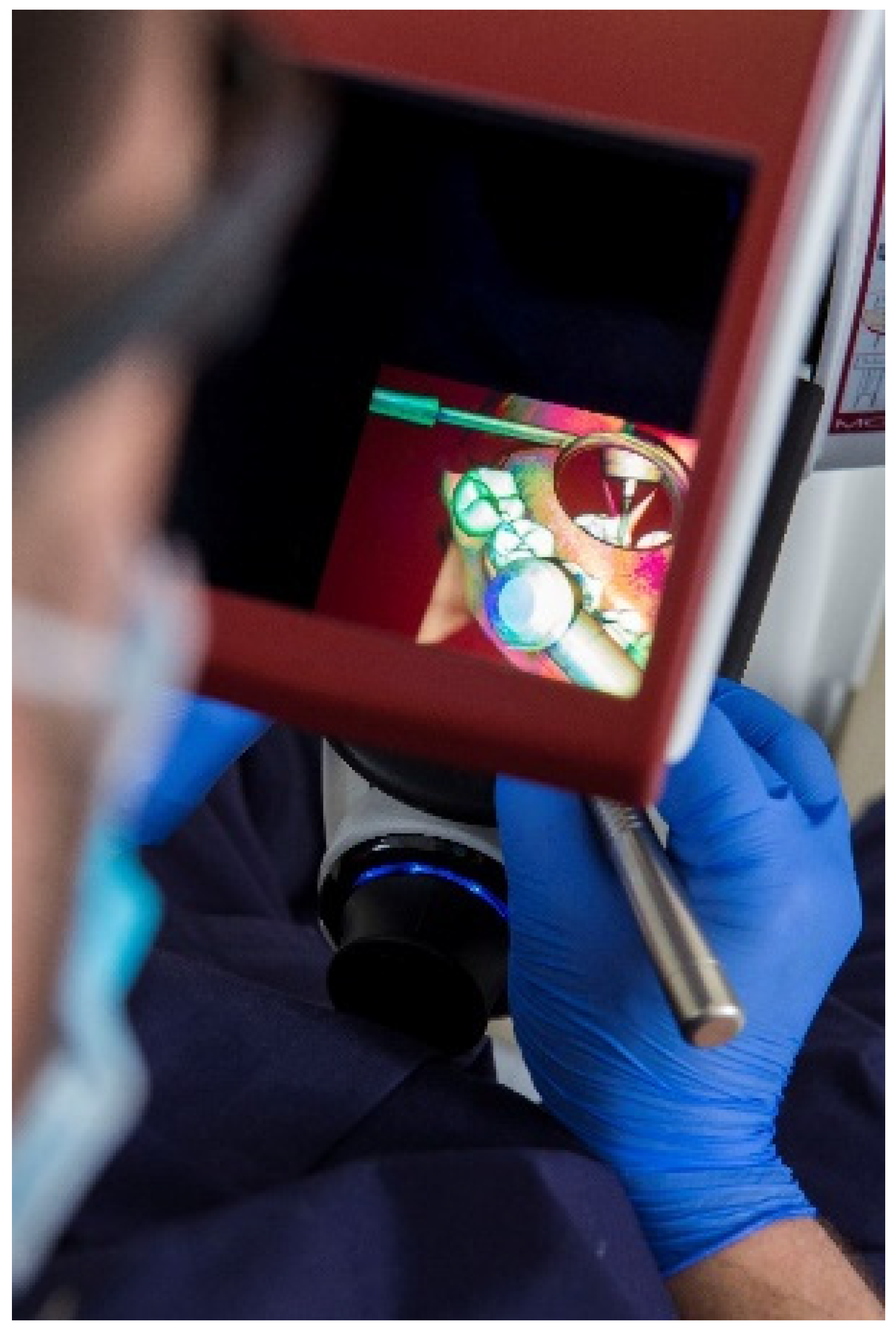
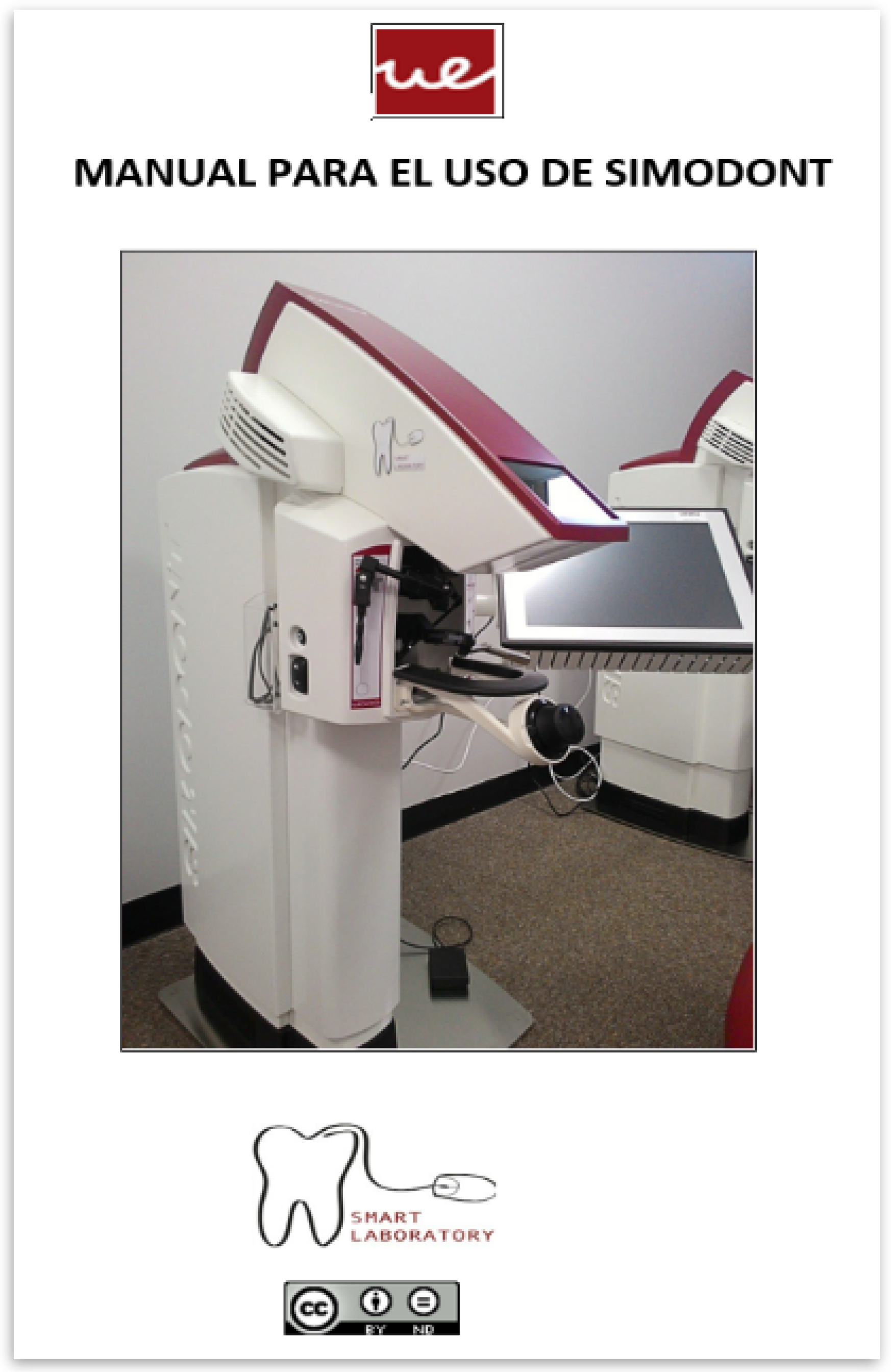
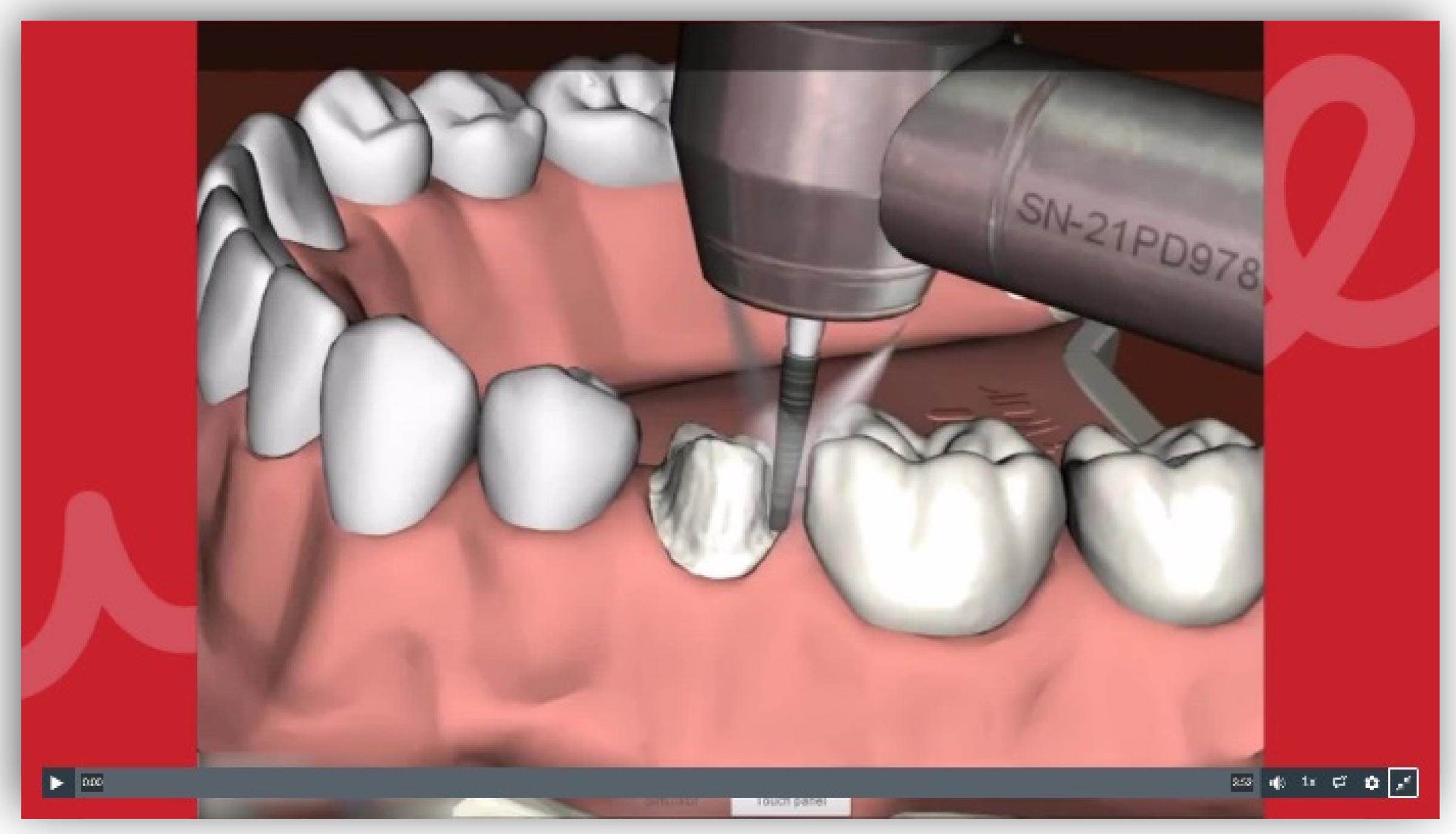
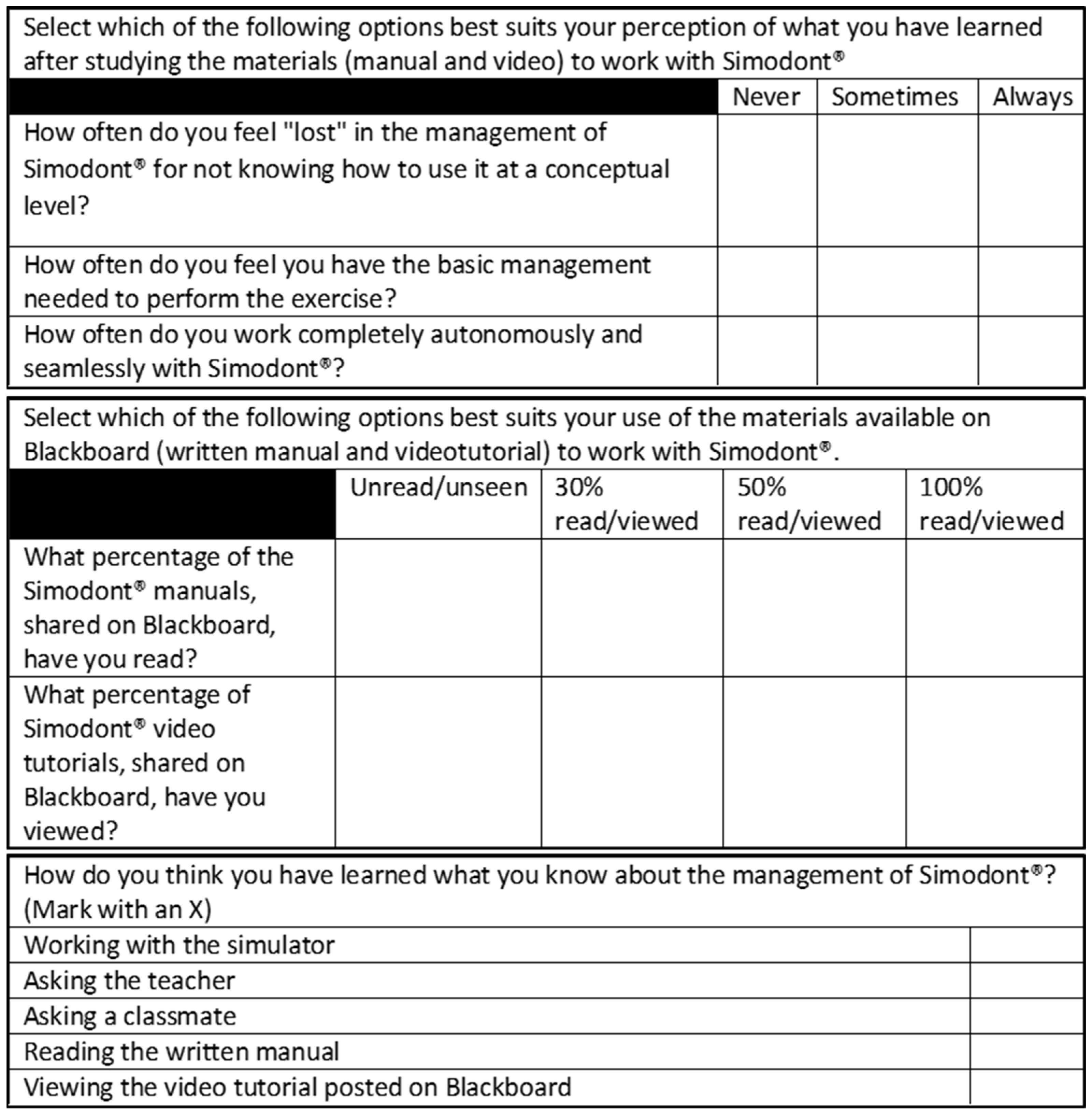
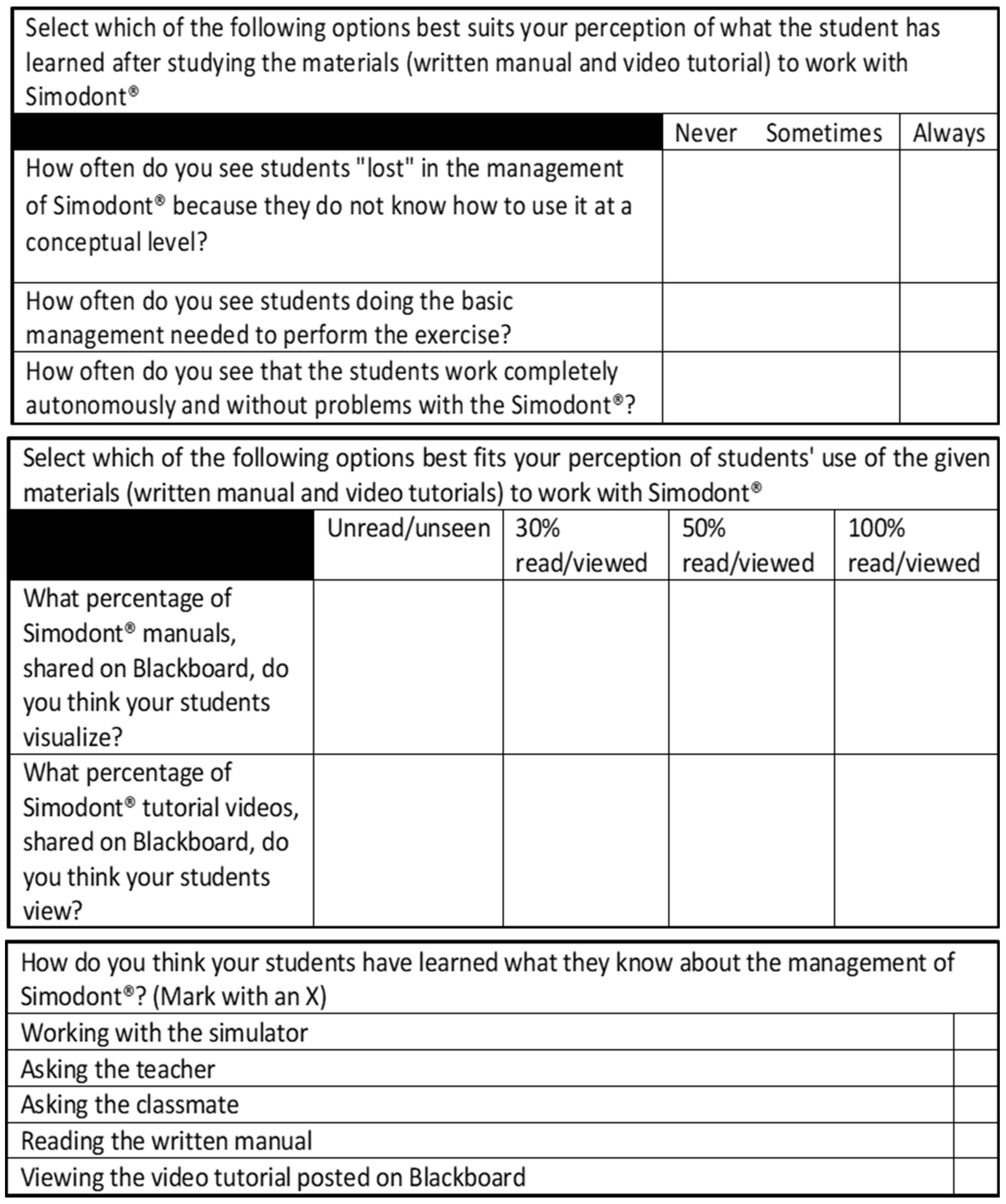
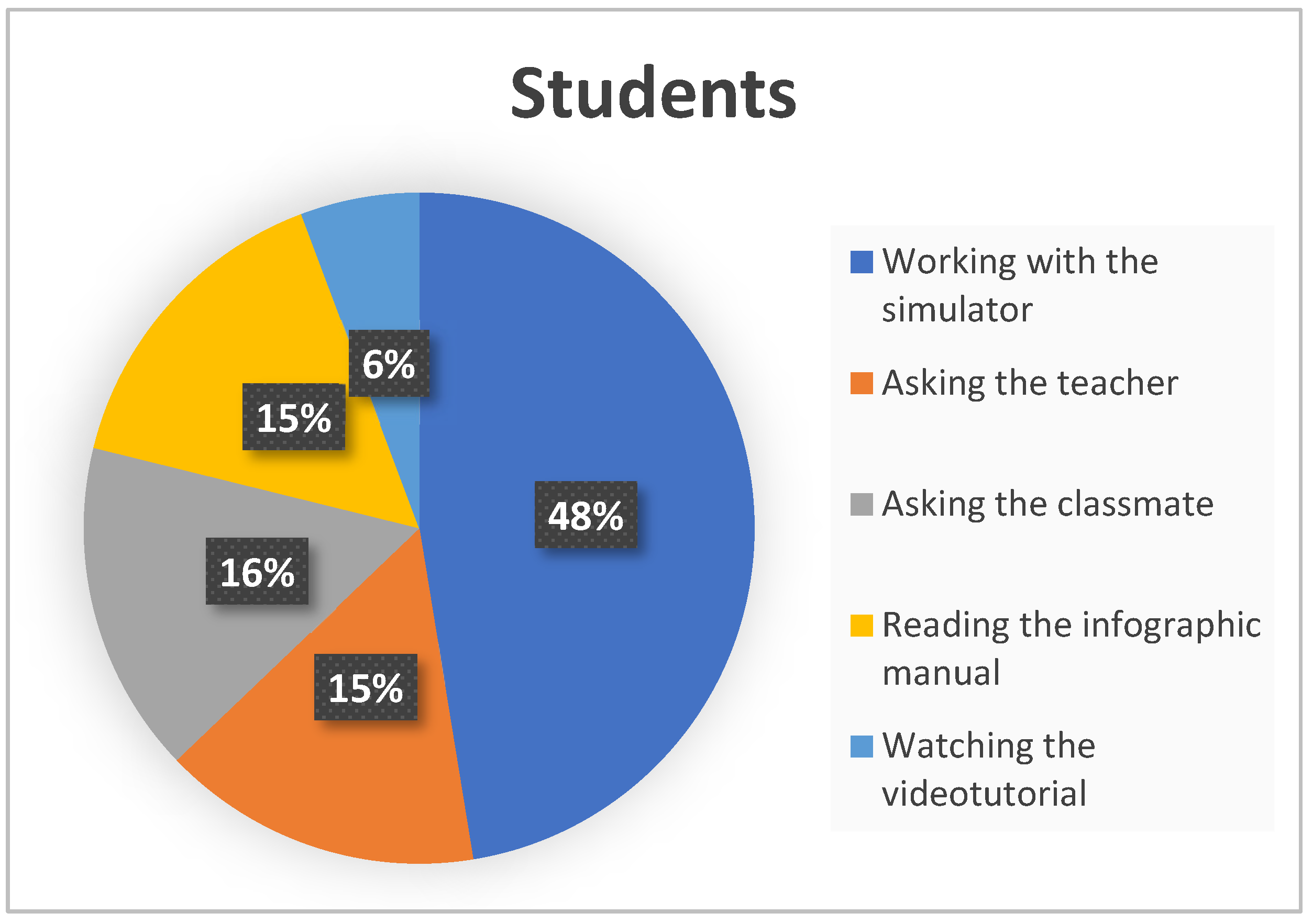
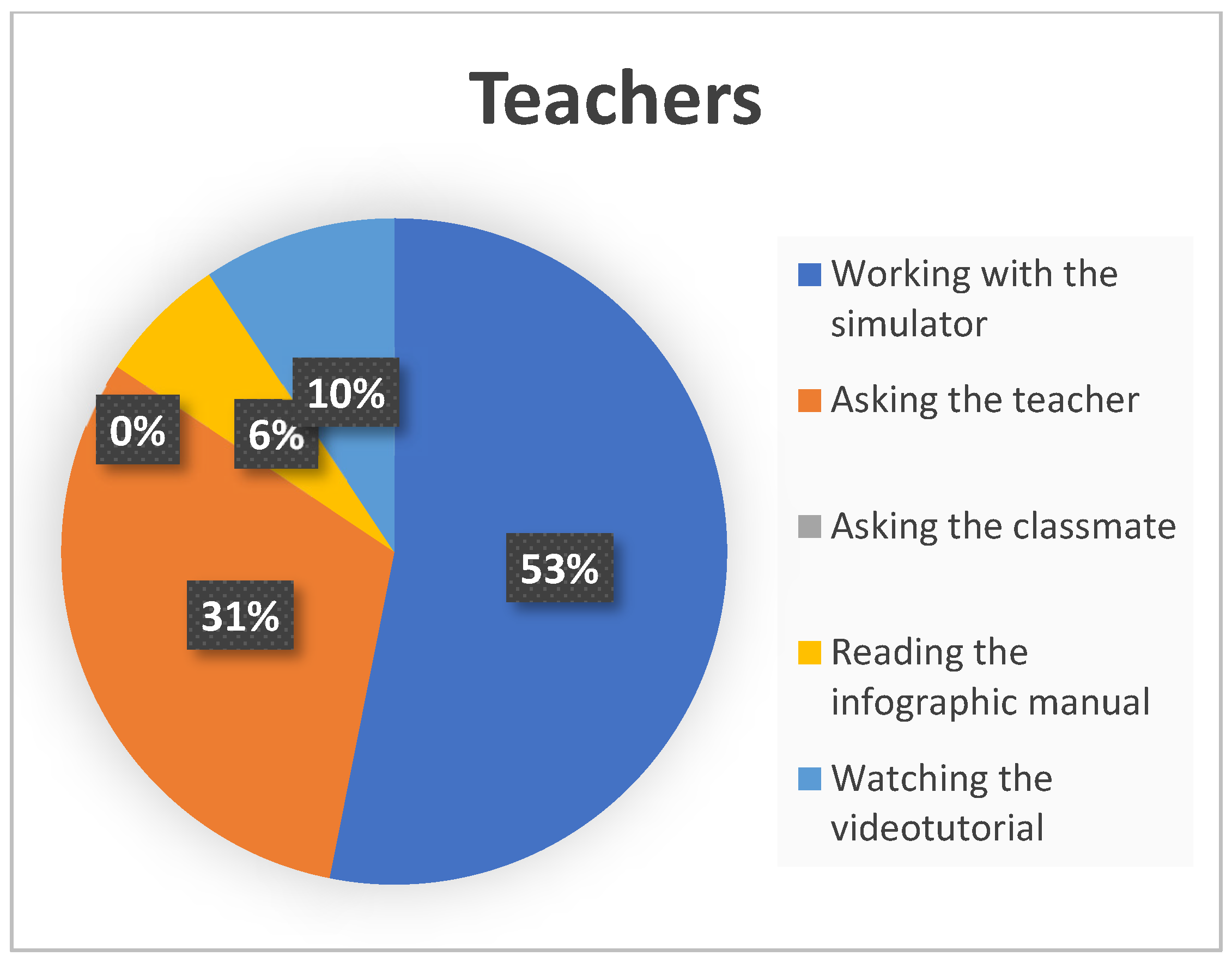
| Variable | Definition | Tool |
|---|---|---|
| Theoretical domain | Know how the simulator works at a conceptual or theoretical level, which does not imply putting it into function. Low level of knowledge/learning. | Polytomous closed questions on the student’s perception of knowledge/learning in use of the simulator. Qualified in 3 levels: 1. Never 2. Sometimes 3 Always Applied to students and teachers. |
| Technical domain | Operate the simulator to the basic level needed to perform the exercise. Medium level of knowledge/learning. | |
| Advanced management domain | Carry out the exercise autonomously and smoothly. High level of knowledge/learning. |
| Variable | Definition | Tool |
|---|---|---|
| Study of the informative written manual | Know the level of assimilation of the resource through its use | Polytomous closed questions about the study of the resource. Qualified in 4 levels: 1. Unread/unviewed 2. 30% read/viewed (Low Level). 3. 50% read/viewed (Medium Level). 4. 100% read/viewed (High Level). Applied to students and teachers. |
| Study of the video tutorial |
| Theoretical Domain | Technical Domain | Advanced Management | Study of the Manual | Video Study | ||
|---|---|---|---|---|---|---|
| n | valid | 175 | 175 | 175 | 175 | 175 |
| lost | 0 | 0 | 0 | 0 | 0 | |
| Mean | 2.34 | 2.47 | 2.09 | 3.43 | 3.22 | |
| Standard deviation | 0.623 | 0.668 | 0.453 | 0.906 | 1.134 | |
| Theoretical Domain | Technical Domain | Advanced Management | Study of the Manual | Video Study | ||
|---|---|---|---|---|---|---|
| n | valid | 32 | 32 | 32 | 32 | 32 |
| lost | 0 | 0 | 0 | 0 | 0 | |
| Mean | 1.97 | 2.50 | 2.31 | 2.84 | 3.34 | |
| Standard deviation | 0.400 | 0.672 | 0.471 | 0.515 | 0.787 | |
| Theoretical Domain | Technical Domain | Advanced Management | Study of the Manual | Video Study | |||
|---|---|---|---|---|---|---|---|
| Spearman’s Rho coefficient | Theoretical Domain | Correlation coefficient | 1.000 | 0.293 ** | 0.293 ** | −0.015 | −0.002 |
| Sig. (bilateral) | . | 0.000 | 0.000 | 0.843 | 0.975 | ||
| n | 175 | 175 | 175 | 175 | 175 | ||
| Technical Domain | Correlation coefficient | 0.29 ** | 1.000 | 0.156 * | 0.122 | 0.077 | |
| Sig. (bilateral) | 0.000 | . | 0.039 | 0.107 | 0.308 | ||
| n | 175 | 175 | 175 | 175 | 175 | ||
| Advanced Management Domain | Correlation coefficient | 0.293 ** | 0.156 * | 1.000 | −0.059 | 0.008 | |
| Sig. (bilateral) | 0.000 | 0.039 | . | 0.436 | 0.912 | ||
| n | 175 | 175 | 175 | 175 | 175 | ||
| Study of the manual | Correlation coefficient | −0.015 | 0.122 | −0.059 | 1.000 | 0.252 ** | |
| Sig. (bilateral) | 0.843 | 0.107 | 0.436 | . | 0.001 | ||
| n | 175 | 175 | 175 | 175 | 175 | ||
| Study of the video tutorial | Correlation coefficient | −0.002 | 0.077 | 0.008 | 0.252 ** | 1.000 | |
| Sig. (bilateral) | 0.975 | 0.308 | 0.912 | 0.001 | . | ||
| n | 175 | 175 | 175 | 175 | 175 | ||
| Theoretical Domain | Technical Domain | Advanced Management | Study of the Manual | Video Study | |||
|---|---|---|---|---|---|---|---|
| Spearman’s Rho coefficient | Theoretical Domain | Correlation coefficient | 1.000 | 0.365 * | 0.393 * | 0.570 ** | 0.370 * |
| Sig. (bilateral) | . | 0.040 | 0.026 | 0.001 | 0.037 | ||
| n | 32 | 32 | 32 | 32 | 32 | ||
| Technical Domain | Correlation coefficient | 0.365 * | 1.000 | 0.544 ** | 0.123 | 0.901 ** | |
| Sig. (bilateral) | 0.040 | . | 0.001 | 0.503 | 0.000 | ||
| n | 32 | 32 | 32 | 32 | 32 | ||
| Advanced Management | Correlation coefficient | 0.393 * | 0.544 ** | 1.000 | 0.186 | 0.499 ** | |
| Sig. (bilateral) | 0.026 | 0.001 | . | 0.309 | 0.004 | ||
| n | 32 | 32 | 32 | 32 | 32 | ||
| Study of the manual | Correlation coefficient | 0.570 ** | 0.123 | 0.186 | 1.000 | 0.108 | |
| Sig. (bilateral) | 0.001 | 0.503 | 0.309 | . | 0.556 | ||
| n | 32 | 32 | 32 | 32 | 32 | ||
| Study of the video tutorial | Correlation coefficient | 0.370 * | 0.901 ** | 0.499 ** | 0.108 | 1.000 | |
| Sig. (bilateral) | 0.037 | 0.000 | 0.004 | 0.556 | . | ||
| n | 32 | 32 | 32 | 32 | 32 | ||
Publisher’s Note: MDPI stays neutral with regard to jurisdictional claims in published maps and institutional affiliations. |
© 2022 by the authors. Licensee MDPI, Basel, Switzerland. This article is an open access article distributed under the terms and conditions of the Creative Commons Attribution (CC BY) license (https://creativecommons.org/licenses/by/4.0/).
Share and Cite
Coro-Montanet, G.; Pardo Monedero, M.J.; Sánchez Ituarte, J.; de la Hoz Calvo, A. Train Strategies for Haptic and 3D Simulators to Improve the Learning Process in Dentistry Students. Int. J. Environ. Res. Public Health 2022, 19, 4081. https://doi.org/10.3390/ijerph19074081
Coro-Montanet G, Pardo Monedero MJ, Sánchez Ituarte J, de la Hoz Calvo A. Train Strategies for Haptic and 3D Simulators to Improve the Learning Process in Dentistry Students. International Journal of Environmental Research and Public Health. 2022; 19(7):4081. https://doi.org/10.3390/ijerph19074081
Chicago/Turabian StyleCoro-Montanet, Gleyvis, María Jesús Pardo Monedero, Julia Sánchez Ituarte, and Ana de la Hoz Calvo. 2022. "Train Strategies for Haptic and 3D Simulators to Improve the Learning Process in Dentistry Students" International Journal of Environmental Research and Public Health 19, no. 7: 4081. https://doi.org/10.3390/ijerph19074081
APA StyleCoro-Montanet, G., Pardo Monedero, M. J., Sánchez Ituarte, J., & de la Hoz Calvo, A. (2022). Train Strategies for Haptic and 3D Simulators to Improve the Learning Process in Dentistry Students. International Journal of Environmental Research and Public Health, 19(7), 4081. https://doi.org/10.3390/ijerph19074081








